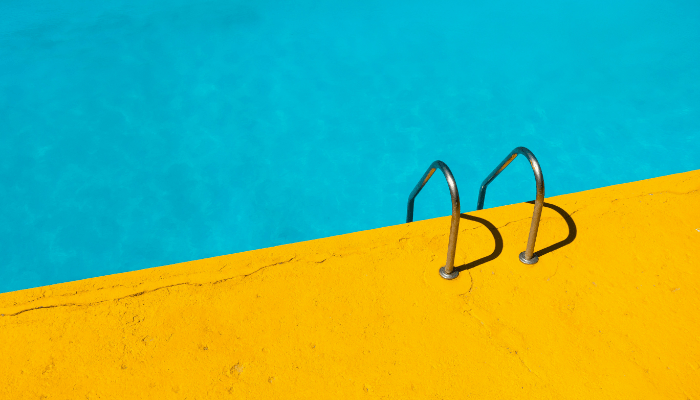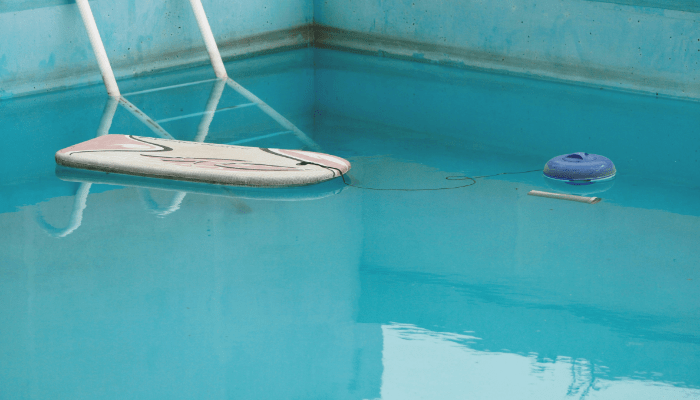Key Takeaways
Converting a traditional pool into a pond can cut maintenance costs by up to 90% while creating a thriving ecosystem that attracts birds, insects, and beneficial wildlife.
Not every pool is ideal. Concrete pools are easiest to convert, depth matters (at least 3 feet for fish), and structural issues should be addressed before starting.
Draining and prepping the pool responsibly is essential. Remove pool hardware and consider adding gravel, clay, or liners to create a natural base.
Choose your pond type: wildlife, fish, swim, or ornamental, and design filtration accordingly with plants, beneficial bacteria, and natural substrates.
A mix of submerged, floating, and marginal plants forms a natural filtration system, reducing algae and stabilizing water quality.
Introduce life gradually: start with plants and bacteria, then add snails or insects, and finally fish, ensuring balance and oxygenation.
Avoid common mistakes like skipping biological filtration, overloading fish, or using invasive plants; even a natural pond needs thoughtful maintenance.
Done right, your old pool becomes a beautiful, self-sustaining feature: less work, lower costs, and a backyard that feels alive.
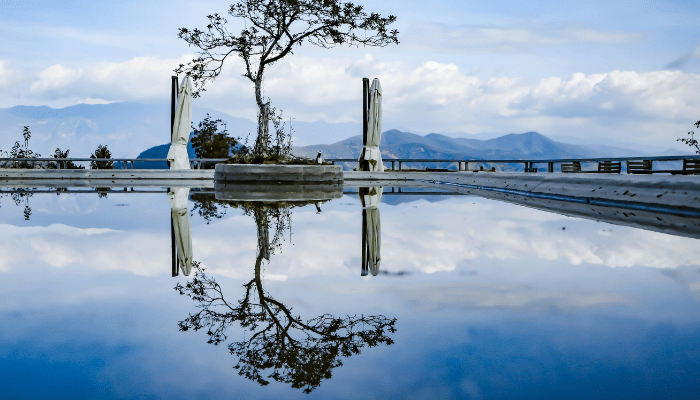
Your pool was fun. Once. Maybe twice. Then it became a never-ending cycle of chlorine refills, filter cleanings, and sky-high water bills. It’s time to stop fighting nature and start working with it. Converting your pool into a pond means less maintenance, lower costs, and an actual ecosystem, not just a lifeless hole filled with chemicals.
What if, instead of an expensive, chemical-laden hole in the ground, you had a thriving, self-sustaining ecosystem?
Turning a pool into a pond isn’t just a trend. It’s a smart, eco-friendly investment. In fact, natural pools and ponds can cut maintenance costs by 90% compared to traditional swimming pools. Plus, they attract birds, butterflies, and all kinds of beneficial wildlife. Imagine stepping outside to the sound of frogs, the sight of dragonflies zipping across the water, and a pond that practically takes care of itself.
But here’s the catch: you can’t just fill your pool with hose water and call it a day. Converting a pool into a pond requires careful planning, the right balance of plants and bacteria, and a bit of patience. Get it right, and you’ll have a crystal-clear, living pond that enhances your backyard for decades. Get it wrong, and you’ve just created a murky, mosquito-infested swamp.
Your pool was fun. Once. Maybe twice. Then it became a never-ending cycle of chlorine refills, filter cleanings, and sky-high water bills. It’s time to stop fighting nature and start working with it. Converting your pool into a pond means less maintenance, lower costs, and an actual ecosystem, not just a lifeless hole filled with chemicals.
This guide will show you exactly how to turn that underused swimming pool into a stunning, self-sustaining pond. Let’s get to work.
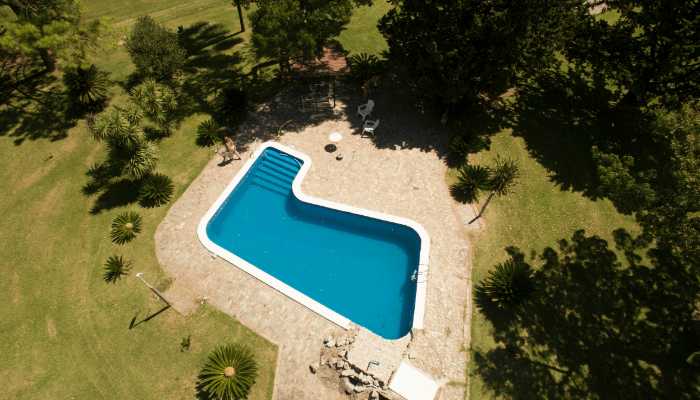
Assessing Your Pool for Conversion
Not all pools are created equal. Some make for fantastic pond conversions, while others might need more work. Before you start tearing things apart, ask yourself.
What is your pool made of? Concrete pools are the easiest to convert. Vinyl liners can work, but they tend to degrade over time. Fiberglass pools? Possible, but you’ll need to rough up the surface for plants to take hold.
How deep is it? If you want fish, at least 3 feet deep is ideal. Shallow pools work too, but they’ll heat up quickly in summer.
Is it structurally sound? Check for leaks or cracks. A pond doesn’t need to hold water perfectly, but large structural issues could be a problem.
If your pool passes the test, it’s time to drain it and start fresh.
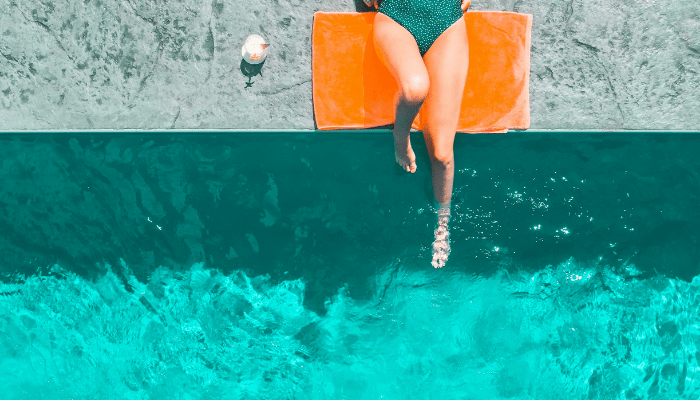
Draining and Preparing the Pool
First, don’t just yank the plug and flood your yard. Be responsible.
- If your water has chlorine or salt: Let it sit for a few days so the chemicals dissipate.
- If your pool is treated with harsh algaecides or other chemicals: Pump the water into a sewer drain, not your yard.
- If your water is clean: Use it to water your lawn or garden, it’s a free irrigation system.
Once the water is out, remove everything that screams “pool.” That means skimmers, ladders, tiles, and pool filters. If you’re serious about making it a true pond, take out any plastic or artificial lining. The goal is to create a natural environment, not a fake pond in a plastic tub.
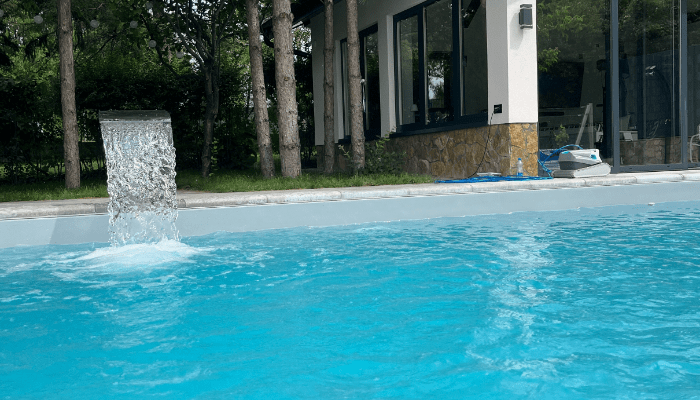
Choosing the Right Pond Type
Now, decide what kind of pond you actually want. Not all ponds serve the same purpose, so choosing the right type upfront will save you a lot of work later.
Wildlife Pond
If you want a self-sustaining, chemical-free ecosystem, a wildlife pond is your best bet. Designed to attract native species like frogs, dragonflies, and birds, these ponds rely on plants and natural bacteria to keep the water clean. There are no pumps, no filters, and no fish, just a thriving aquatic habitat.
Best for: Eco-conscious homeowners, nature lovers, and those who want a completely hands-off pond.
Fish Pond
Thinking of adding koi, goldfish, or even native fish? A fish pond requires a deeper water level (at least 3 feet), proper oxygenation, and some level of filtration to keep water quality stable. You’ll also need to monitor waste levels since fish can produce excess nutrients that lead to algae problems.
Best for: People who love watching fish, have time for moderate upkeep, and want a pond that’s alive with movement.
Swim Pond
A swim pond is the natural, chemical-free alternative to a traditional swimming pool. It’s designed with two zones:
- A swimming area (deep, open water, no plants).
- A regeneration area (shallow zone filled with plants that naturally filter the water).
Since swim ponds rely on natural filtration, they need careful planning to ensure clear, clean water.
Best for: Anyone who loves swimming but wants to ditch chlorine and maintenance-heavy pools.
Ornamental Pond (Oásis Biosistema Ponds)
For those who want a stunning, artistic water feature, ornamental ponds are the way to go. Oásis Biosistema specializes in beautifully designed, low-maintenance ponds that blend natural filtration with striking aesthetics. These ponds often include waterfalls, stonework, and strategically placed aquatic plants to create a balanced, visually stunning water feature. Unlike wildlife or fish ponds, the goal here is aesthetics first, with a controlled environment that stays clear and clean.
Best for: Homeowners looking for a showpiece pond with minimal upkeep.
Each pond type has its own set of requirements, but the next step which means setting up a natural filtration system is essential for all of them.
Creating a Natural Filtration System
Forget chlorine. Nature has a better way.
Biological Filtration: This is the heart of a healthy pond. Beneficial bacteria break down waste, keeping water clear. You can use lava rocks, biofilters, or plant-based filtration zones.
Mechanical Filtration: Not always necessary, but helpful if you want ultra-clear water. Simple options include pond skimmers or a slow-flow waterfall.
Plants, plants, and more plants: The best natural filter. Aim for a mix of submerged, floating, and marginal plants:
Oxygenators (Submerged Plants): Hornwort, anacharis. These help keep water clean.
Floating Plants: Water lilies, duckweed. They shade the pond and limit algae growth.
Marginal Plants: Cattails, irises. They create a natural shoreline.
A well-planned plant system means less maintenance and fewer algae problems.
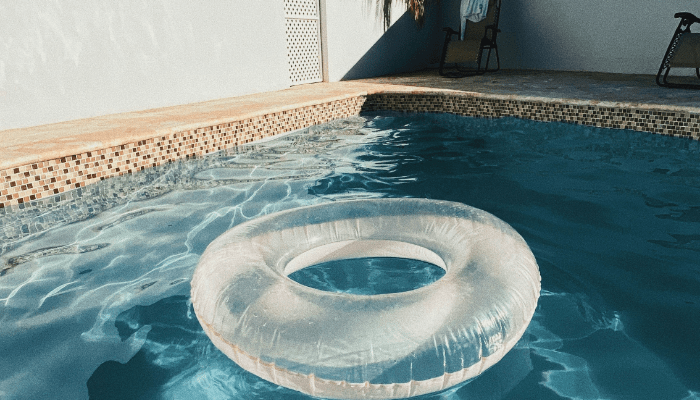
Sealing the Pool and Adding a Natural Substrate
Some people leave their concrete pool as is. That works, but it’s not the most natural solution. If you want a truly organic look, consider these 3 options.
- Clay Sealant (Bentonite Clay): Creates a natural, waterproof layer.
- Rubber Pond Liner: More work to install but lasts for decades.
- Gravel and Sand: Helps beneficial bacteria thrive.
Even if you keep the concrete, adding a layer of gravel at the bottom makes a huge difference. It gives beneficial bacteria a place to grow and makes the pond look more like a natural body of water, not an old swimming pool.
Introducing Plants and Wildlife
Now for the fun part. Time to bring life into your pond.
Start with plants before adding any animals. They help stabilize the ecosystem.
Introduce beneficial bacteria. You can buy them in liquid or powder form.
Add small critters first: Snails, freshwater shrimp, or native aquatic insects.
Then, introduce fish. Goldfish are hardy and low-maintenance. Koi are beautiful but need deeper water. Native fish like bluegill or minnows? Perfect if you want a natural balance.
If you’re patient, wildlife will start showing up on its own. Birds, frogs, and dragonflies will all make themselves at home.

Managing Water Quality & Pond Maintenance
Here’s the best part: maintenance is minimal compared to a pool.
Algae? Too much sunlight, not enough plants. Add floating plants for shade.
Murky water? You may need more oxygenation. Consider a bubbler or waterfall.
Mosquitoes? If your pond is properly balanced, dragonflies and fish will take care of them.
A well-built pond stabilizes itself over time. Unlike a pool, you’re not fighting against nature. You’re working with it.
Enhancing Your Pond
Now that your pool-turned-pond is thriving, why stop there?
Add a waterfall or stream: keeps water moving, prevents stagnation.
Build a natural edge: use logs, rocks, or native plants to create a shoreline.
Encourage biodiversity: birdhouses, bee hotels, or even a small marsh area.
A pond isn’t just a replacement for a pool. It’s an opportunity to create a living, breathing ecosystem.

Common Mistakes to Avoid
Learn from others’ mistakes before you make them yourself or simply get Oásis Biosistema to make you one.
Skipping filtration. Even natural ponds need biological filtration.
Overloading with fish. Too many fish = too much waste = murky water.
Using the wrong plants. Some species can overrun your pond. Stick to native plants.
Not planning for maintenance. A pond is low maintenance, not zero maintenance.
Get it right, and your pond will thrive for years with almost no effort.
Your old swimming pool? A thing of the past. Instead, you now have a self-sustaining, low-maintenance, and absolutely beautiful pond. One that doesn’t require chlorine, doesn’t drain your bank account, and doesn’t demand endless hours of cleaning.
Nature has taken over. And this time, that’s a good thing.
Conclusion
By now, you know exactly what it takes to transform a lifeless pool into a thriving pond. You’ve learned how to swap out chemicals for nature’s own filtration system, how to choose the right plants and fish, and how to make sure your new pond doesn’t turn into a murky disaster.
It won’t happen overnight. Nature works on its own timeline, but the payoff is worth it. Soon, you’ll have a pond that’s clean, clear, and teeming with life. No chlorine. No expensive upkeep. Just a self-sustaining ecosystem that benefits both you and the environment.
So, what’s next? Start planning. Take measurements. Sketch out your pond’s design. And if you’re feeling ambitious, start draining that pool.
Because the sooner you start, the sooner your backyard stops being a maintenance headache, and starts becoming your own personal paradise.
Tired of chlorine? Let nature take over.
At Oásis Biosistema, we transform traditional pools into thriving natural ponds that are beautiful, balanced, and low-maintenance.
Request your free quote today and give your pool a second life.
FAQ
Can a swimming pool be converted to a pond?
Yes, a swimming pool can be converted into a pond with proper adjustments.
Can I use a swimming pool as a fish pond?
Yes, with proper modifications, a swimming pool can be used as a fish pond.
What can you convert a swimming pool into?
You can convert a swimming pool into a pond, garden, water feature, or even a garden bed.
Can I use a swimming pool pump for a pond?
It depends on the pump’s specifications, but in many cases, a pool pump can work for a pond with proper filtration adjustments.

